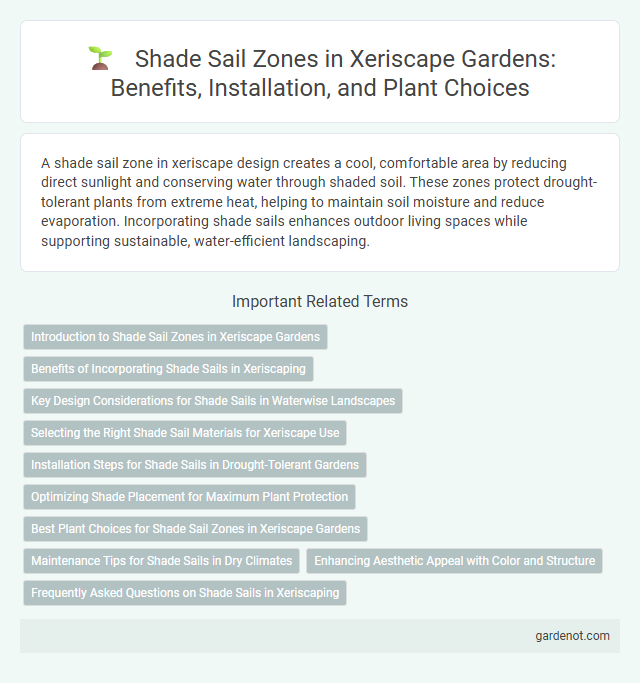A shade sail zone in xeriscape design creates a cool, comfortable area by reducing direct sunlight and conserving water through shaded soil. These zones protect drought-tolerant plants from extreme heat, helping to maintain soil moisture and reduce evaporation. Incorporating shade sails enhances outdoor living spaces while supporting sustainable, water-efficient landscaping.
Introduction to Shade Sail Zones in Xeriscape Gardens
Shade sail zones in xeriscape gardens play a crucial role in reducing water evaporation and protecting drought-tolerant plants from intense sun exposure. These zones utilize strategically placed sail-like fabric structures that create partial shade, fostering microclimates ideal for heat-sensitive species and enhancing overall garden sustainability. Incorporating shade sails helps optimize water conservation efforts and supports the growth of resilient plant varieties suited for arid landscapes.
Benefits of Incorporating Shade Sails in Xeriscaping
Incorporating shade sails in xeriscaping significantly reduces water evaporation by providing crucial shade, thereby conserving moisture for drought-tolerant plants. Shade sails also protect delicate xeric vegetation from intense sunlight, promoting healthier growth and reducing plant stress. These structures enhance outdoor comfort, making xeriscape gardens more usable and sustainable in arid climates.
Key Design Considerations for Shade Sails in Waterwise Landscapes
Key design considerations for shade sails in xeriscape or waterwise landscapes include optimal placement to maximize shade over drought-tolerant plants and reduce water evaporation. Selecting durable, UV-resistant fabric enhances longevity while allowing air circulation to maintain plant health. Proper tensioning and drainage prevent water pooling, ensuring the shade structure supports sustainable irrigation practices.
Selecting the Right Shade Sail Materials for Xeriscape Use
Selecting the right shade sail materials for xeriscape zones involves prioritizing UV resistance, durability, and breathability to support water-efficient landscaping. High-density polyethylene (HDPE) fabrics offer excellent sun protection while allowing airflow, reducing heat buildup and conserving moisture. Choosing materials with strong tensile strength and weather-resistant coatings ensures long-lasting performance in arid environments where water conservation is critical.
Installation Steps for Shade Sails in Drought-Tolerant Gardens
Installing shade sails in drought-tolerant gardens involves selecting durable fabric materials that block UV rays and provide ample shade for xeriscape plants. Securely anchoring the sails to sturdy support posts or existing structures using stainless steel hardware ensures stability during various weather conditions. Proper tensioning of the sails prevents sagging, promoting optimal water conservation by reducing soil evaporation in shaded zones.
Optimizing Shade Placement for Maximum Plant Protection
Optimizing shade placement in a xeriscape shade sail zone involves strategically positioning sails to shield drought-tolerant plants from intense midday sun, reducing water evaporation and stress. Selecting locations based on plant species' sun exposure needs enhances their growth and longevity by providing intermittent shade during peak heat hours. Proper angle adjustment and sail size can maximize coverage, ensuring efficient microclimate control and improved landscape sustainability.
Best Plant Choices for Shade Sail Zones in Xeriscape Gardens
Succulents like Agave and Aloe thrive in xeriscape shade sail zones due to their drought tolerance and low maintenance. Ferns such as the Autumn Fern provide lush greenery while requiring minimal water, making them ideal for shaded areas under shade sails. Shade-tolerant ground covers like Liriope and Heuchera also enhance soil moisture retention and reduce erosion in xeriscape gardens.
Maintenance Tips for Shade Sails in Dry Climates
Shade sails in xeriscape gardens require regular cleaning to prevent dust and debris buildup common in dry climates. Inspect fabric tension and hardware connections frequently to avoid sagging and ensure durability against strong winds. Use UV-resistant materials and apply water-based treatments to extend fabric life and reduce fading from intense sun exposure.
Enhancing Aesthetic Appeal with Color and Structure
Shade sail zones enhance xeriscape designs by incorporating vibrant colors and geometric structures, creating focal points that complement drought-tolerant plants. The use of UV-resistant fabric in various hues adds dynamic visual interest while providing necessary shade, reducing water evaporation from soil. Structurally, tensioned shade sails offer architectural contrast, blending functional sun protection with artistic expression to elevate outdoor spaces efficiently.
Frequently Asked Questions on Shade Sails in Xeriscaping
Shade sails in xeriscaping provide efficient sun protection while conserving water by reducing soil evaporation and heat stress on drought-tolerant plants. Common questions include optimal placement to maximize shade without blocking rainfall, selecting UV-resistant, breathable fabric materials, and ensuring secure installation to withstand wind. Proper maintenance involves periodic cleaning and tension adjustments to prolong fabric life and maintain functionality in arid landscapes.
Shade sail zone Infographic

 gardenot.com
gardenot.com